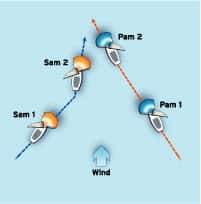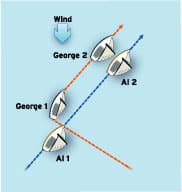
Every fourth year, ISAF publishes a set of revised racing rules. The Racing Rules for 2001-2004 go into effect April 1. Over the next few months, I will describe how the racing rules for 2001-2004 differ from the rules we sailed under last year. First, Ill cover the changes coming in Part 2 of the rules–those that apply when boats meet. These are the rules that are most crucial to all competitors and judges. After that, Ill systematically review the changes in the other parts of the rulebook.
Each Part 2 rule thats been changed is shown in a box with any new wording underlined, and each is followed by a discussion of the reasons for the change and its implications.
Rule 16.2–Changing Course
In addition, when after the starting signal boats are about to cross or are crossing each other on opposite tacks, and the port-tack boat is keeping clear of the starboard-tack boat, the starboard-tack boat shall not change course if as a result the port-tack boat would immediately need to change course to continue keeping clear.
New Rule 16.2 will only apply when boats on opposite tacks are in a crossing situation. In Diagram 1 two boats are about to cross each other, and Rule 16.2 applies in this situation. As Sam, on starboard, and Pam, on port, approach each other, Pam is far enough ahead that she can cross ahead of Sam without Sam taking avoiding action. When Sam bears off and, consequently, Pam immediately needs to take avoiding action, then Sam breaks Rule 16.2. The rule doesnt apply if Stan and Pete are not in a crossing situation. However, when Stan luffs, Rule 16.1, which requires Stan to give Pete room to keep clear, does apply. That rule always applies whenever a right-of-way boat changes course.
Readers will want to know when one boat is about to cross another. Just like about to pass, a phrase used in Rule 18.1 and discussed in ISAF Case 84, when a boat is about to cross another will depend on the circumstances–the wind and sea conditions as well as the speeds and handling characteristics of the boats.
Rule 17.1–On the Same Tack; Proper Course
If a boat clear astern becomes overlapped within two of her hull lengths to leeward of a boat on the same tack, she shall not sail above her proper course while they remain overlapped within that distance, unless in doing so she promptly sails astern of the other boat. This rule does not apply if the overlap begins while the windward boat is required by Rule 13 to keep clear.
I have underlined two changes in new Rule 17.1. There are some other changes intended to make the rule easier to read, but they dont change the intended meaning in any way. The addition of promptly is important when Rule 17.1s restriction applies to a leeward boat on a reach or run that decides to drop behind the windward boat in order to try to roll over the top of her. While overlapped to leeward, the leeward boat may head higher than her proper course only if she promptly sails astern of the other boat. She can no longer hassle the other boat by luffing her higher for a while before dropping astern.
The last sentence of new Rule 17.1 is completely new. It was added because of the difficulty of deciding whether or not Rule 17.1 applies right after one boat slam-dunks another. In Diagram 2, when George slam-dunks Al, an overlap begins while Rule 13 applies to George (i.e., during the time after George passes head to wind but before hes on a closehauled course). The new last sentence implies that Rule 17.1s proper course limitation doesnt apply to Al in this situation. However, if the overlap begins after George completes his tack, then Rule 17.1 limits Als course.

Rule 19.1(b)–Room to Tack at an Obstruction
The hailed boat shall … immediately reply “You tack,” in which case, the hailing boat shall tack as soon as possible and the hailed boat shall give room …
The words “as soon as possible” replace “immediately” in the second line of Rule 19.1(b). To see why this was done, consider the following situation. Nell is closehauled on starboard tack approaching a rocky shore and is unable to tack without colliding with Norman, who’s on her windward hip. She nervously hails “Room to tack!” Rule 19 gives Norman two choices. He must either tack or reply “You tack.” Under old Rule 19.1(b) if Norman replied “You tack,” then Nell was required to tack immediately. That requirement has been made more reasonable. Now, Nell must tack “as soon as possible” after Norman’s hail. Under the old rule, Norman could have taken advantage of the strict requirement on Nell to tack immediately and protested her if there was any delay between his hail and her tack.
Rule 20–Starting Errors
A boat sailing towards the pre-start side of the starting line or its extensions after her starting signal to comply with rule 29.1 or rule 30.1 shall keep clear of a boat not doing so until she is completely on the pre-start side.
The words “after her starting signal” were added here so the rule would not apply in the following situation. With the Round-an-End Rule (Rule 30.1) in effect, suppose that Ed crossed the starting line at the pin end 30 seconds before the starting signal and then turned back to round outside the pin-end mark as required by Rule 30.1. Under old Rule 20, he lost all his rights the moment he began to sail back towards the line even though the starting signal had not yet been made. Now, with the added words, Rule 20 will only apply to a boat sailing toward the pre-start side of the line after her starting signal.
Rule 20–Penalty Turns
A boat making a penalty turn shall keep clear of one that is not.
In new Rule 20, “a penalty turn” replaces “penalty turns” because sometimes (for example, if a boat is match racing or if she hits a mark) a boat is only required to make a single penalty turn.
Preamble to Section A
However, some rules in Sections B, C, and D limit the actions of a right-of-way boat.
The preamble now reflects the fact that rules in Section D, as well as rules in Sections B and C, limit the actions of a right-of-way boat. Rules 21 and 22, both in Section D, are examples of such rules.
E-mail for Dick Rose may be sent to rules@sailingworld.com.









